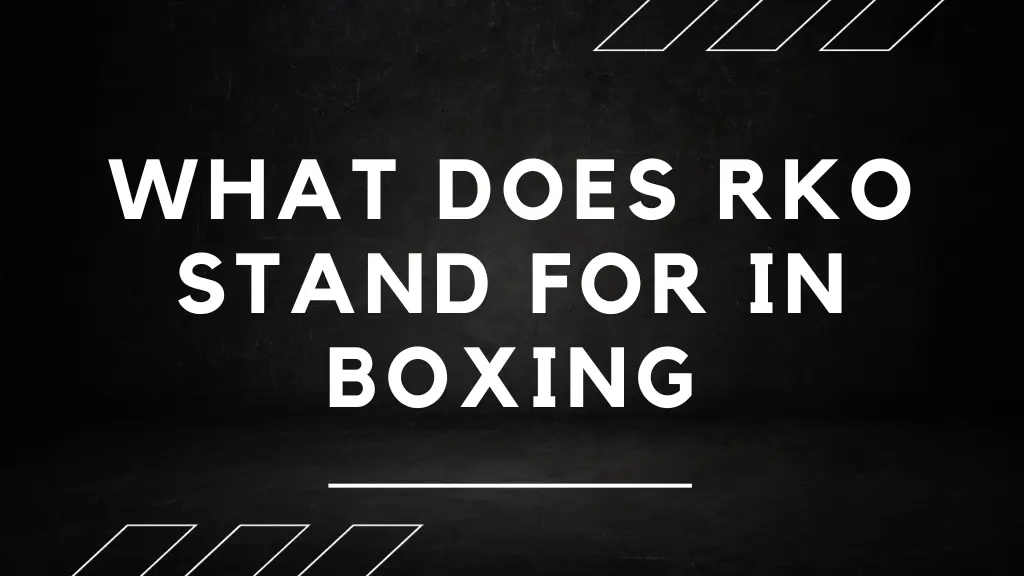In the world of boxing, acronyms like TKO, KO, and RKO are often thrown around, leaving spectators and newcomers to the sport bewildered. While TKO and KO are more commonly understood as “Technical Knockout” and “Knockout,” respectively, RKO seems to be shrouded in mystery. In this blog post, we’re going to unravel the enigma surrounding RKO in boxing and explore what does RKO stands for in boxing and its significance in the ring.
what does RKO stand for in boxing
RKO, in the context of boxing, has nothing to do with a Hollywood film studio but is an acronym for “Referee’s Knockout.” It is a less common term used to describe a situation where the referee stops a fight, declaring one of the boxers as the winner due to their opponent’s inability to continue or due to a technical violation.
RKO in Boxing: Definition and Purpose
The RKO in boxing carries a unique definition and purpose. In essence, it is a term used to signify that a boxer has been declared the winner of a match by the referee. This decision is typically reached when the referee observes that one of the boxers is no longer able to defend themselves or continue fighting.
The key factors that can lead to an RKO include:
Inability to Continue
If one of the boxers is deemed physically incapable of continuing the fight due to exhaustion, injury, or other factors, the referee may declare an RKO. This is a crucial aspect of the referee’s responsibility in ensuring the safety of the fighters.
Excessive Punishment
Another scenario that can lead to an RKO is when one boxer is subjected to excessive punishment by their opponent. Excessive punishment can indicate to the referee that the fighter’s safety is at risk, prompting the referee to make the RKO call to protect the boxer from further harm.
Disqualifying Foul
A disqualifying foul committed by one of the boxers can also result in an RKO. This indicates a breach of the rules that is so severe that the match cannot continue. The offender may be declared the loser, and their opponent is declared the winner via RKO.
The Technique Behind the RKO
The decision to declare an RKO is not a simple matter of chance; it involves a well-defined technique that relies on the careful observation and judgment of the referee. It is crucial to understand that an RKO is not a random or arbitrary declaration, but rather a result of the referee’s keen assessment of the situation unfolding in the boxing ring.
Referees play a pivotal role in ensuring the safety of the boxers while upholding the rules and regulations of the sport. Their responsibilities extend beyond merely overseeing the match; they must possess a deep understanding of the sport’s intricacies and nuances. Here’s a glimpse into the technique that guides the decision to declare an RKO:
-
Constant Vigilance
Referees are trained to maintain unwavering focus throughout the match. They closely monitor every aspect of the bout, including the boxers’ movements, defensive capabilities, and overall physical condition. -
Awareness of Rule Violations
Referees are acutely aware of the rules and regulations governing boxing. They watch for any fouls, violations, or infractions that occur during the match. If a disqualifying foul is committed, it can lead to an RKO decision. -
Assessment of Fighter’s Safety
The safety of the boxers is paramount. Referees evaluate the physical well-being of the fighters, looking for signs of excessive fatigue, injury, or distress. If a boxer is unable to protect themselves adequately or is at risk of serious harm, the referee may step in. -
Communication with the Boxers
Referees may also communicate with the boxers during the match, checking on their condition and ability to continue. They might ask the fighters to “show them something” to prove they can go on. Failure to respond appropriately can influence the RKO decision. -
Judgment Calls
Ultimately, the decision to declare an RKO rests on the judgment of the referee. It’s a split-second decision that considers all of the above factors, and more. Referees must have the wisdom and experience to make the right call in the best interest of the fighters and the integrity of the sport.
RKO vs. TKO: Key Differences
In the world of boxing, acronyms like RKO and TKO are often used interchangeably, leading to confusion. However, it’s crucial to differentiate between the two, as they have distinct meanings and implications in the sport.
TKO (Technical Knockout)
A TKO signifies that one of the boxers is unable to continue fighting due to their physical condition. This condition is typically the result of severe injury or a significant number of knockdowns. The fighter might be too injured or weakened to stand up and continue the bout.
In a TKO, the referee counts the seconds while the downed fighter attempts to get up.If the fighter fails to rise before the referee counts to ten, the referee declares the match in favor of the opponent as a TKO.
RKO (Referee’s Knockout)
An RKO isn’t just about a boxer’s physical condition. It covers injuries, disqualifying fouls, rule breaches, and a fighter’s inability to defend effectively.
The key difference lies in the referee’s judgment based on in-ring circumstances in an RKO. It is not solely reliant on a fighter’s physical state but also takes into account the rules and safety considerations.
RKO in Iconic Boxing Matches
In boxing history, “RKO” means explosive finishes. Referees call it, electrifying the sport. Fighters celebrate their legendary status. Each instance adds intrigue, leaving an indelible mark on boxing. Let’s delve into a few of these remarkable moments:
-
Muhammad Ali vs. Sonny Liston (1965)
This historic match was marred by controversy and is often remembered for the “Phantom Punch.” During the first round, Ali (then known as Cassius Clay) delivered a swift right hand that sent Liston to the canvas. The referee, Jersey Joe Walcott, declared an RKO, and Ali emerged victorious. However, many spectators and experts questioned the legitimacy of the punch, adding to the enigma of this bout. -
Mike Tyson vs. Andrew Golota (2000)
In this fight, Mike Tyson, known for his ferocious punching power, faced Andrew Golota. After Golota received a series of powerful punches, the referee decided that Golota could no longer continue. The fight was declared an RKO in favor of Tyson. -
Evander Holyfield vs. Mike Tyson (1997)
This infamous rematch is etched in boxing history for a different reason. During the bout, Tyson bit off a piece of Holyfield’s ear, leading to a disqualification and an RKO victory for Holyfield. This match is a prime example of an RKO being declared due to a disqualifying foul.
Floyd Mayweather Jr. vs. Victor Ortiz (2011)
In a fight that stirred controversy, Mayweather faced Ortiz. In the fourth round, Ortiz headbutted Mayweather, and the referee paused the fight to penalize Ortiz. During this interruption, Mayweather delivered a swift punch, knocking Ortiz down. The referee counted to ten, declaring an RKO and securing victory for Mayweather.
Training for the Ideal RKO
Perfecting the RKO in boxing is far from a stroke of luck. It entails rigorous training and strategic refinement. Both boxers and their trainers dedicate considerable time and effort to acquire the necessary skills to execute an impeccable RKO. Here’s a closer look at the training and preparation required to master this pivotal technique.
-
Physical Conditioning and Stamina
Building and maintaining exceptional physical condition is paramount. Boxers need the endurance to execute the RKO effectively, ensuring they remain robust and agile throughout a match. -
Meticulous Footwork
The key to RKO success often lies in agile and precise footwork. Boxers must position themselves strategically in the ring, capitalizing on the opportune moment for an RKO. -
Solid Defensive Skills
The ability to defend against an opponent’s attacks is critical for a successful RKO. Boxers must be skilled at blocking, parrying, and slipping punches. -
Sharp Offensive Skills
Executing the RKO requires flawless offensive techniques. Boxers diligently practice their punching precision, speed, and power to deliver the decisive blow. - Mental Fortitude
Maintaining composure under the pressure of a match is a must. Boxers train their minds to make pivotal decisions in the heat of battle.
RKO in Popular Culture: Beyond the Boxing Ring
The impact of the RKO reaches far beyond the confines of the boxing world. This section delves into how the term has permeated popular culture, making appearances in movies, video games, and even internet memes.
Movies: On occasion, the term “RKO” finds its way into film dialogues and scripts, particularly in action or sports-related movies. It serves as a nod to the thrilling and dramatic moments of boxing matches and the theatrical appeal of the RKO decision.
Video Games: Within the realm of video games, especially in boxing simulations and combat-oriented games, references to the RKO are not uncommon. Players can experience the exhilaration of executing or defending against an RKO in a virtual gaming environment.
Internet Memes: The widespread recognition and fascination with the RKO have led to its incorporation into internet memes and viral videos. These lighthearted and often unexpected RKO-themed memes feature the move in unconventional, and at times comical, contexts.
RKO and Safety Concerns in Boxing
The RKO, while delivering thrilling moments in the world of boxing, raises legitimate safety concerns for the fighters involved. These concerns revolve around the physical risks associated with forceful maneuvers, particularly to the head and neck, which can lead to head trauma and concussions. Ethical considerations are paramount, with referees tasked with prioritizing the well-being of boxers in their decision-making.
Related Post: Boxing Reach Measurement Guide
Conclusion
In the world of boxing, the RKO stands as a unique and at times enigmatic element that infuses depth and intrigue into the sport. Whether we celebrate or debate it, the RKO maintains its position in the annals of boxing history as a pivotal moment capable of shifting the course of a match. Comprehending its importance in the ring enhances our overall appreciation of this dynamic sport.
FAQs
-
What does RKO stand for in boxing?
RKO stands for “Referee’s Knockout” in the context of boxing. It is a term used when the referee declares one of the boxers as the winner due to their opponent’s inability to continue or a technical violation. -
How is an RKO different from a TKO?
While both involve the referee making a decision, a TKO (Technical Knockout) typically indicates that one boxer is unable to continue due to severe injury or multiple knockdowns, while an RKO may involve rule violations and other factors. -
Who are some famous boxers known for using RKO?
Boxers like Muhammad Ali and Mike Tyson are known for their strategic use of the RKO to secure victories in their matches. -
Is the RKO a dangerous move in boxing?
The RKO itself is not a move but a referee’s decision. However, the circumstances leading to an RKO can involve safety concerns, as it indicates that one of the boxers is no longer able to continue the fight.




